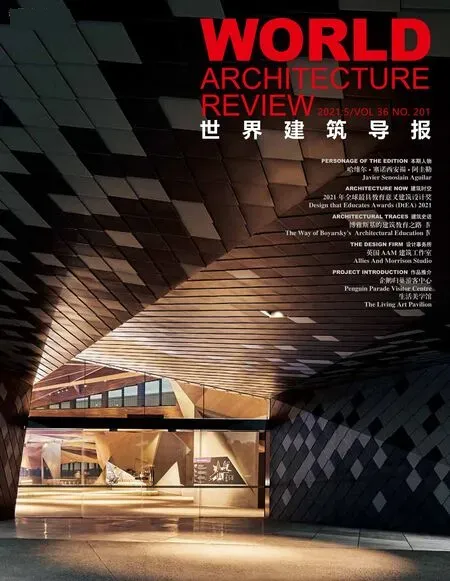一个家庭制陶匠
文/Text:温贝托·里卡德G./HUMBERTO RICALDE G.
哈维尔·塞诺西安禓·阿圭勒的建筑作品总是富有创造性,毫无疑问,每每惊羡旁人且经久不衰。它充满了问题,尤其对我们这些功能理性学派的人来说,它由我们构成。翻开这本著作,我们会产生许多与阅读《生物建筑》时一样的问题:一个必然孕育着我们的建筑?铺设着并与地形、植被相重合?怎么建?随着时间推移,它会有何变化?
直到哈维尔找到语言描述他最近的作品,他也对这个搜索过程感到惊讶:这是七十年代以来其他当代建筑师中难见的恢弘而又浓墨重彩的殷实之作,尽管处于与丹尼尔·阿雷东多合作初期,其体现的体感与色觉都恰传承于大师路易斯·巴拉甘。但哈维尔·塞诺西安禓·阿圭勒进行了令人不安的冒险。
分析一下探索初期的“浮动金字塔”。房屋厚重的本体悬浮于景观之上,梯形橙色赭石搭载混凝土牢牢地巴住粗糙地形,点缀,试着抚平它,下层活动地带和天然绿屏随着花园自然生长,平坦的屋顶置于其上。“绿”的集大成,与房屋视野、墙面色彩、天窗设计、烟囱排口等设计可谓可歌可叹。其后几年的探索和作品不言而喻:“棱镜对”建筑或“生产绿洲”首创红色、粉色、橙色、紫色相结合,将四周的绿衬得近乎透亮。
哈维尔的作品犹如昙花一现,非同寻常,整个墨西哥现代建筑圈一如文学界期待创世之作一般,沉静却又兴奋的期待着下一次建筑作品的熠熠生辉。1985 年,此书中记录的“有机别墅”不仅探求意义上的有机统一,建筑过程有机化也得以实现。这一创新过程的详细记录有力地证明了哈维尔和他陶匠团队对有机建筑的建造已达到炉火纯青的地步。
比起概念,这些房屋更标志着人与自然相亲相爱,相依相融,对建筑史意义深远。屋顶光滑,草坪下盘覆的三角梅、常春藤、长春花生动地传递着自然的脉搏。
除了关心住宅怎样才能住得舒适合理,怎么在家中展开活动之外,家具的设计遵从了一统的有机理念,而浴室、起居室、厨房等的问题是:这些建筑要起到多大的决定作用?当然,当时有所困惑的笛卡尔抽象形式轮廓的架构今日趋于流行。
“有机别墅”之后的文章清晰描述了哈维尔建筑形式表达的完整过程。跟随作家勾勒自由的曲线,绕过葱郁的树木,滑下当地的斜坡,现场房屋的轮廓,尤其是铁丝网水泥的使用(一种在钢丝网上使用混凝土的实验形式)都将浮现在我们眼前,反过来,哈维尔创作进入纯熟阶段便从这开始:房屋与草原、灌木、树木和爬山虎融为一体,交相辉映。“走在花园里的同时你也踩在自己屋顶上”。
从这时起,作品蕴含了奇异的惊喜和困惑,进入了新纪元。它与墨西哥之前二十年产生的平庸建筑关系是无法解释的,它独一无二且未被公开发表,但却意义非凡。从极致光度到舒适的半光,平滑的暗色调为我们绘制了一幅又一幅图景。延展性空间将这种建筑感官达到极致。正如作者在谈到“墨西哥鲸”时强调的那样,气动定心和聚氨酯的应用使“墙壁,地面和屋顶间无需支撑或连接;床、桌子和壁橱之类必要家具间亦不需要……”;与人们一直追求的创新建筑体系截然不同。房子外层覆盖着多色陶瓷片用来保护和固定,其形式和程序创新颠覆了悠久的莫桑比克、加泰罗尼亚和墨西哥传统。
因此,书中分析的形式、建筑过程、选地和生活方式正是哈维尔作品的不竭动力,也是我们久久不平的惊喜与躁动的来源;许多关乎作品的问题都将在我们了解到他已经坚定地要成为一个“家庭制陶匠”时迎刃而解。
Javier Senosiain’s architecture is always a discovery and,undoubtedly,a surprise that causes intrigue and certain restlessness;it is full of questions particularly for those of us who were formed on the functional rational school where,it should be said,he was formed with us.The questions are accumulated when opening this book of his work as it happened when reading his book of bioarchitecture:An architecture that inexorably cradles us? that is laid and overlapped with topography and vegetation? How to build it? How will its behavior be throughout time?

The Shark (El Tiburón_Edo.de México,1990)

The Tree House_La Casa del Árbol_Celaya,2013
Javier also surprises with his searching process until he finds the language that characterizes his recent work:the work of what we can name his first period performed jointly with Daniel Arredondo is characterized by a thick,volumetric and palpitating presence of coloring in tones and ranges,difficult to find in works of other contemporary Architects that since the seventies have practiced,with different fortunes,the volumetric and coloring language,which roots,as we well know,are in the multi-referred Luis Barragan.But in Javier Senosiain there is a disturbing and provocative step.
Just analyze the“Floating Pyramid”of this first search period.The thick volume of the house is suspended over the landscape,the big ocher-orange trapezoids placed on concrete,anchor it to the harsh terrain where it is located and this allows to dot it,propitiating,at the same time,that the terrain slides under it,and its untouched green area is increased with the garden on which the flat roof has become.The green integration and the house views,the wall colors,the skylight,the chimney draft,etc.undoubtedly announce the searches for the next years and works:the“Prismatic Pair”Building or the“Production Oasis”on challenging reds,pinks,oranges,purples,make the surrounding green almost fluorescent by means of challenging contrasts.
In the integral and modern Mexican architecture society,these unusual gestures are not so frequent and,since the appearance of the above mentioned works,a growing surprise has accompanied the architectonic production of Javier,although with a silent expectation as the intellectual society is used to.The next definite step was taken on 1985,as it is extensively documented in this book,with“The Organic House”,whose search is not only in the sense of the organic form but also on experimentation with the construction procedures that make it architectonically possible;on this matter,the photographs of the innovative processes are eloquent with which Javier and his group of real construction pottery makers carried out the organic houses of their maturity.
Maybe the greatest impact of these houses,since their conception,is their integration to the outdoor space,to the green that literally does not surround them but rather cradle and clothe them;the tide of bougainvilleas,ivies,periwinkles,contrasting with the smooth skin of the lawn of their roofs,haptically transmit the concept that generated them.
A different approach also lies in this concept,beyond the functional and rational matter of how a house must be inhabited,of how the activities developed in it must be cradled by the forms of the own house,which is reflected in the design of bathrooms,living rooms,kitchens,etc.,where the furniture integrated to the organic constructive forms is fixed,the question is:How determining,from a formal point of view,must the architecture be? Of course,including in this question the architecture of Cartesian abstract formal profile,which nowadays is in fashion.
The integrated process of Javier Senosiain’s architecture formal expression is clearly described in the text that accompanies“The Organic House”.There you can follow,step by step,the free outlining of the curves that shape it,avoiding the existing trees in the area and sliding down the local slopes,as well as the house outlining at the site and particularly its construction by means of ferro-cement,an application procedure of concrete on steel meshes,suitable for the experimental forms that characterize this house;which in turn,marks the beginning of the author’s work maturity stage:The house is sheltered by its own ground and integrated to the place among grasslands,shrubs,trees and creepers until“ walking in the garden means walking on the house own roof”.
From here on,the work is transformed and shows strange surprises and distribution questions;its relation with mean architecture produced in Mexico in the last twenty years is,to mention the least,inexplicable and in the same sense singular and unpublished.The images take us through scenarios literally shaped by smooth toned down colors ranging from extreme luminosity to cozy half-light;ductile spaces haptically transmit their qualities up to a limit of tectonic sensuality,achieved in contrast with a continuous search for innovative building systems as the author underlines when speaking about“The Mexican Whale”where the application of pneumatic centering and the expected polyurethane make possible the“continuous volumes without joints or frame jambs between the walls,ground and roofs;even with basic elements of furniture:beds,tables and closets…”;in the outside,the house is covered with polychrome ceramic pieces that work as protective epidermis and anchor,contrasting in its form and innovative procedures with a long Mozarabic,Catalan and Mexican tradition.
Therefore,the stress between forms,building procedures,site adaptation and the proposed way of living in its spaces,is what originates on all of us such feeling of surprise and restlessness when discovering Javier Senosiain’s architecture and analyzing his built work comprised in this book;many of the questions that the above mentioned work raises will be clarified as we understand that he has firmly become a“ home pottery maker”.

Grave (Sarape y Sombrero_Edo.de México,1992)

